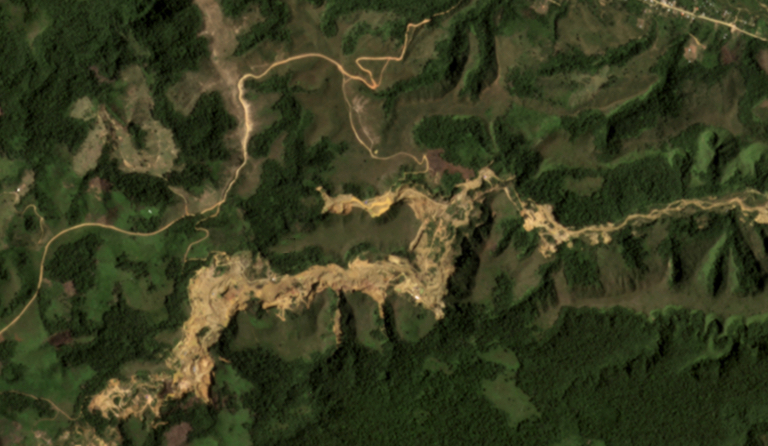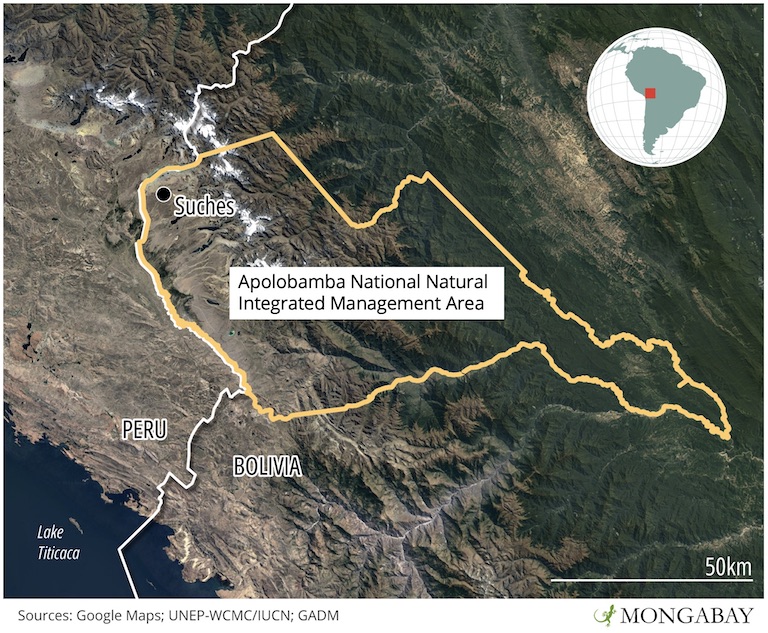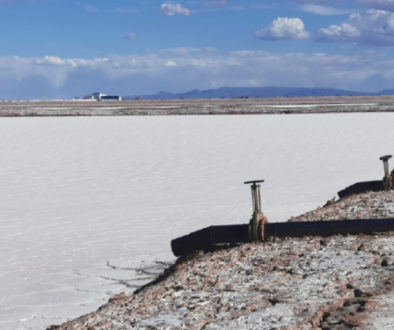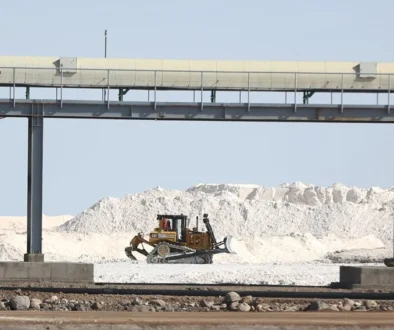In a Bolivian protected area torn up for gold, focus is on limiting damage. (Mongabay. 2/05/23)
- Artisanal gold mining by local cooperatives abounds in protected areas across Bolivia, in particular the Apolobamba highlands near the border with Peru.
- The mining boom here began in the late 1990s, and since then the cooperatives have continued to use mercury amalgamate the gold.
- There are worries over mercury contamination as well as the diversion of river flows away from wetlands to the mines.
- NGOs working with the cooperatives say the local miners are keen on making their operations more sustainable, but that the cost and lack of government support are hurdles to achieving this.
LA PAZ — At dawn in Apolobamba, in the Bolivian highlands, groups of vicuña and alpaca — some sheared, some shaggy — amble around looking for scrub to graze on, though the frozen ground offers little. The scene is silent, but for the clanks and rumbles of machinery at the nearby gold mines.
Apolobamba is a protected area northwest of La Paz, Bolivia’s political capital, that borders Peru. It holds a vast array of ecosystems, from the 6,000-meter (20,000-foot) peaks of the Cordillera de Apolobamba, to the high plateau at around 4,000 m (13,000 ft) and tropics that spill down to 600 m (2,000 ft) above sea level. Its rivers feed Lake Titicaca and the Amazon. And the riverbeds are scattered with particles of gold, as is much of the rest of Apolobamba.
Vicuñas (Vicugna vicugna) and alpacas (Lama pacos) were once Apolobamba’s main economic resource. But in the last two decades, high gold prices have driven communities to set up mining cooperatives, calling back relatives who had migrated out in search for work, and finding investors to pay for the heavy machinery. Today, there are more than 200 cooperatives working in the protected area, according to Oscar Loayza, former director of Apolobamba and now coordinator of GIT-OR, a civil society group focused on reducing the negative impacts of gold mining. Loayza added that more than 30% of the territory of Apolobamba has been awarded in mining concessions.
Driving around the sectors of Puyo Puyo and Suches in the high plateau, where much of the gold mining takes place, Mongabay observed how the landscape was being reshaped. The driver preferred not to stop to take photos, or to be identified in this article.

The high plateau of Apolobamba is flat and treeless, but holds a unique Andean wetland ecosystem that receives glacial meltwater from the mountains of the Cordillera. Some of that water is now being diverted by miners, who channel it toward their open-pit mines, where it is used on “chutes” — sloped wooden structures where truckloads of earth are hosed with water and run through channels to separate a relatively gold-rich sediment. This is then treated with mercury, which binds together the particles of gold into a solid amalgam that makes it easier to extract. The process is inefficient: the driver estimated it recovers 35% of the gold. But it requires relatively little investment to begin operation.
Suches, where mining is most intense, looks like it’s been bombarded. What was once flat land is now piles of upturned earth and craters of turbid water. Trucks, heavy machinery and brand-new four-wheel-drive vehicles reflect the millions of dollars being invested and made in a place that’s now dedicated to mining. In the town of Suches itself, the statue in the central plaza is that of a backhoe.

“Ten years ago the people here were ranchers who did some mining,” said the driver. “Now they’re miners who do a little ranching.”
A complicated history
Apolobamba has existed in its current form since 2000, when it was expanded from a smaller protected area, Ulla Ulla, which was created in 1972 to protect its then-endangered vicuñas. Today, it has more gold mining activity than any other protected area in Bolivia.
There has long been a small amount of mining in the mountains, in the sector of Pelechuco, but the seed for today’s open-pit boom was sown when Downer Mining, a New Zealand company, began operating in Suches in the late 1990s.
“This opened the eyes of the local people,” Loayza said. “They realized there was gold there, too.”

Then the price of gold began to climb. In 2000, it sold for roughly $400 per ounce. In 2011, it peaked at an inflation-adjusted price of $2,424 per ounce, before dipping back down. Since 2020 it has hovered at around $2,000, reflecting investors’ perception of gold as a hedge against inflation and a safe haven amid economic uncertainty. This meant even inefficient operations could be profitable.
Local residents obtained mining concessions in Apolobamba. They were able to do so because, in Bolivia, extractive activities are allowed in certain parts of protected areas.
“Every protected area has levels of zoning,” said Danilo Bocángel, general manager of MEDMIN, a foundation that works with miners to improve their environmental practices. “Some zones can’t be touched. But others can, and some can even have intensive extraction — in other words, full, uninhibited mining.”
In the case of Apolobamba, the zones where mining was forbidden were relatively few and small. They became even smaller in 2015, when the protected area’s management plan was redesigned — with input from the miners themselves, according to Oscar Campanini, executive director of CEDIB, an environmental NGO.
“Between 2013 and 2015, most protected areas saw their management plans updated, and in practically all of them there was a trend towards changing the zoning to allow extractive projects,” Campanini said. “In some cases it was hydrocarbons, in others it was hydroelectrics, and in this case it was mining.”
The government has supported gold mining in other ways, too, by subsidizing fuel, keeping royalties on gold exports low, cutting taxes on the import of heavy machinery, and so far resisting calls to regulate the import and use of mercury, despite having signed the Minamata Convention and thereby committing itself to phasing out use of the toxic substance.

The combination of high prices and state support has made gold mining one of the most important economic activities in Bolivia. In 2022, gold was Bolivia’s top export, worth $2.7 billion. Almost all of this is produced not by the state or private companies, but by cooperatives like those in Apolobamba, where a group of people obtain a concession, then make deals with others who have capital and machinery. An estimated 100,000 people are directly employed by gold mining cooperatives, in a country of 12 million.
What marks out the gold mining in Apolobamba is the central role of local residents. According to Loayza, almost every cooperative has local involvement, though he added there’s also a great degree of external investment involved in some operations. Some of the protected area’s 32 communities now have no industry or way of life other than mining, the driver said, while others combine mining with ranching and commerce on the border with Peru. Even if a community doesn’t have its own cooperative, its residents will often work for the cooperatives of other communities. This means that, for many, if not the majority, of people in Apolobamba, gold mining is their most important source of income. Campanini said that although there have been conflicts between miners and non-miners over water use and pollution, there’s no organized resistance to mining.

Most of the operations in Apolobamba do, however, operate in a legal gray zone. Many are breaking the letter of the law in some way, either by rerouting rivers, not restoring the land they mine, or even working in the glaciers themselves, which is strictly forbidden. According to government data from 2019, only about 15% have an environmental license. But working without an environmental license is an administrative infraction, punishable with a fine, not a prison sentence.
The job of monitoring the cooperatives falls to Apolobamba’s underresourced park rangers, who have to balance upholding the law with maintaining relations with the communities and the cooperatives so as to be able to conduct inspections and administrative processes. (In other protected areas, rangers have found themselves barred from communities.)
“For the communities, mining means development,” said Ramiro Mayta, the director of Apolobamba. “And that means they might see us conservationists as obstructing their development.”
Meanwhile, mining is expanding into new areas. Suches, the sector where the boom began, is increasingly exhausted. But the cooperatives that worked there now have some capital, and they’re setting up elsewhere in the protected area. “In 2021, there were 134 new requests [for mining rights] in Apolobamba,” Mayta said.

“Suches used to be a little town that was dedicated to ranching alpacas, and many people migrated [elsewhere] for work,” Mayta added. “Then they came back to mine, and it has gone well for them. In 2012 we went to inspect, mine by mine, to see if they were owners of the machinery. And 50% of them were already owners of their own machinery. Ten more years have passed. Now they are going to the tropics as investors.”
A toxic industry
The gold mining in Apolobamba takes different forms depending on where it is. Most of it is open-pit mining in the high plateau sectors of Suches, Antaquilla and Puyo Puyo. But there’s also gold being mined from rock in Pelechuco and Aguablanca. And, increasingly, there’s alluvial mining happening in the rivers of the lower, forested parts of Apolobamba, such as the area around Achiquiri.
Though studies are scarce, water pollution and land cover change from mining are affecting the habitat of the protected area’s diverse wildlife, which includes vicuñas, Andean bears (Tremarctos ornatus) and condors (Vultur gryphus), as well as new species that continue to be described. In the high plateau, mining devastates the land where it takes place and puts mercury into the water system. But Loayza said its most serious ecological impact is the use of water and the effect on high-altitude wetlands. Mining operations reroute water such that it never arrives in the wetlands. As a result, some parts have dried up. Moreover, operations release used water back into the system, which transports sediment and mercury to downstream ecosystems.
“These are very fragile ecosystems that require permanent and high-quality water,” Loayza said. “If you reduce that quality, they start to die. And if you take the water away, they disappear completely.”


Apolobamba’s high-altitude wetlands provide food for birds such as the Andean goose (Chloephaga melanoptera) and both wild vicuñas and domestic alpacas, especially in the dry season, which tends to span May to November, when they’re the only part of the high plateau that remains wet and green. Despite changes to the wetlands, Apolobamba’s vicuña population continues to grow, with more than 15,000 currently inhabiting the protected area, according to monitoring data from the Wildlife Conservation Society. But the shrinking wetlands, combined with the increasing territory taken up by mining operations, is reducing grazing sites and therefore the population that Apolobamba can support.
Multiple sources said that as concessions in the plateau are exhausted, miners are moving to new ones in lower, forested parts of Apolobamba. In the lowland areas of the protected area, where rainforest predominates, such as Achiquiri, Charopampa and Michiplaya, alluvial mining operations are redirecting river flow, churning up riverbeds, and releasing mercury into the water system. Satellite data and imagery from Global Forest Watch also show several hotspots of deforestation in lower, forested areas in and near Apolobamba.

Bocángel estimates 25% of deforestation in the lowland part of the protected area is related to gold mining, which involves clearing forest for roads and paths, as well as logging trees to build chutes and redirect the flow of water.
Overall, Loayza said, gold mining is by far the biggest human pressure in Apolobamba. Illegal coca cultivation and timber trafficking are a distant second and third, and limited to lowland forested areas.
In Pelechuco and Aguablanca, where gold is mined from crushed rock, the greatest environmental impact is the intensive use of mercury, according to Loayza. He said that miners here use 7-9 kilograms of mercury per kilo of gold extracted from rock. In comparison, open-pit mining uses perhaps 0.4 kg of mercury per kilo of gold.
“This use of mercury is excessive,” Loayza said. “And when you dig a little deeper, the problem is that they are adding mercury at the initial crushing stage, which is technically completely inappropriate — they could add it later, and add less.”

Mercury readily escapes into the environment when used by mining operations, either into the air when it’s burned off to separate it from the gold, or when miners discard mercury-contaminated wastewater and tailings. Polluted water can then flow downstream toward Lake Titicaca or into the Amazon Basin, depending on which side of the Andes the mining is taking place.
Mercury is a heavy metal and potent neurotoxin that attacks brain and kidney functions, and can lead to death in high-enough concentrations. Mercury persists and accumulates in aquatic environments, where it can be transformed into methylmercury and magnify up the food chain. Research conducted elsewhere in South America indicates residents of fishing-dependent human communities downstream of gold mining operations have unsafe levels of mercury in their blood, putting them at increased risk of birth defects, illness and death.


In recent years, several non-peer-reviewed studies have examined mercury levels in hair samples from riverside communities downstream from mining operations in the Bolivian Amazon. There’s no single internationally accepted safe limit for mercury levels in humans, but the U.S. Environmental Protection Agency has set a safe limit of 1 part per million (ppm) in hair samples, while in 2018 the United Nations carried out a global mercury assessment and concluded that in most populations without significant mercury exposure, the level tends to be less than 2 ppm. The studies in the Bolivian Amazon found many communities have average hair mercury levels of more than 2 ppm, and some closer to 7 ppm. In pregnant women, such levels could induce permanent neurodevelopmental effects in fetuses.
There have been no published studies of mercury levels in human populations on the western side of the Andes, where the watershed feeds into Lake Titicaca, though there was a conflict between local communities and upstream miners a decade ago. The communities said their fishing and agriculture had suffered because of mining-related pollution; the government mediated and the conflict was resolved with economic compensation. Other studies have found mercury levels in plants and soils in Apolobamba and in the water of Lake Suches, the Suches River and Lake Titicaca that exceed baseline levels. But the effects of this contamination remain unknown, and it’s difficult to attribute responsibility given the certain amount of natural mercury coming from the Cordillera, and the proliferation of mining operations in the watershed — not just in Bolivia, but also in Peru.
Working towards a more sustainable future
The experts who spoke with Mongabay agree that, given the involvement of locals and the permissiveness of the government, there are few options to stop or even reduce gold mining in Apolobamba. “But we have to reduce the damage being done,” Bocángel said.
NGOs such as MEDMIN, WCS and Helvetas have worked with 15 cooperatives, out of around 1,500, to improve their environmental practices. This entails, for example, building dams where their wastewater can be temporarily stored, allowing contaminated sediment to sink to the bottom before the water is released into the surrounding environment. It also includes adopting technologies to help concentrate minute quantities of gold as much as possible before adding mercury, thereby reducing the amount of mercury required, and then heating the amalgam in a closed system that captures the mercury vapor, which can then be collected and reused.
Mongabay observed the technologies in use at Águilas de Oro, a mining cooperative in Puyo Puyo, where miners gathered as MEDMIN’s technicians explained how to use a gravitation table and a retort, adding two steps to the extraction process. By the end of the training session, 50 truckloads of earth had been transmuted into a nugget of gold weighing 15.2 grams, or just less than half an ounce — with all of the mercury captured.



In theory, such technologies could reduce mercury loss to near zero. The main obstacles to their use becoming widespread are the strength of habit among miners and the small economic incentive to reuse mercury, given its low cost. Loayza said these NGO programs need to become public policy to have a large-scale impact. Fecoman, the union for gold mining cooperatives in La Paz, has said it’s open to using such technologies — with government support.
Águilas de Oro is among the minority of cooperatives that has an environmental license. It was founded by five locals in 2009, one of whom told Mongabay that he used to rear alpacas, but could never earn enough to have a family. He left Apolobamba to work in a gold mine in the tropics, before coming back to establish his own.
“We always knew there was gold here,” he said. “When I was five, my sister saw foreigners looking for gold in the water.”

The fact that many of the miners in Apolobamba are local is a small source of hope for those seeking to reduce the impact of mining.
“They aren’t outsiders whose only interest is to extract everything they can and then leave,” Bocángel said. “They feel connected to those rivers and those mountains. They use mercury, but try to use less. And when an institution like MEDMIN arrives, they listen to what you say and try to change their way of working.”
But even here, large areas of the landscape have been devastated. And with hundreds of other operations in Apolobamba, the question lingering for those concerned about the future of the protected area is how much damage will be done by the time the boom passes. And that’s something that, ultimately, won’t happen until the price of gold comes down — or until there’s no gold left.
In a Bolivian protected area torn up for gold, focus is on limiting damage


